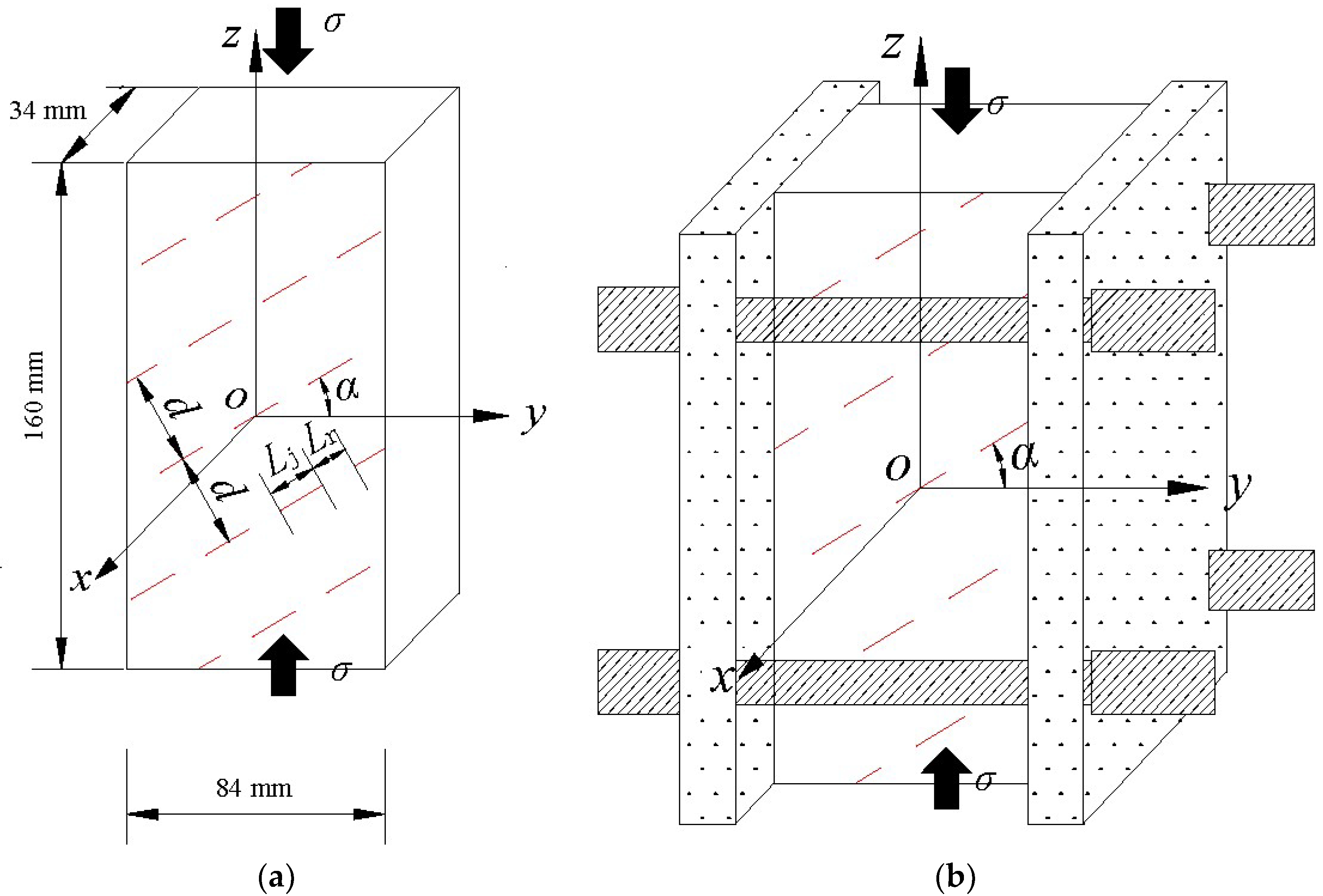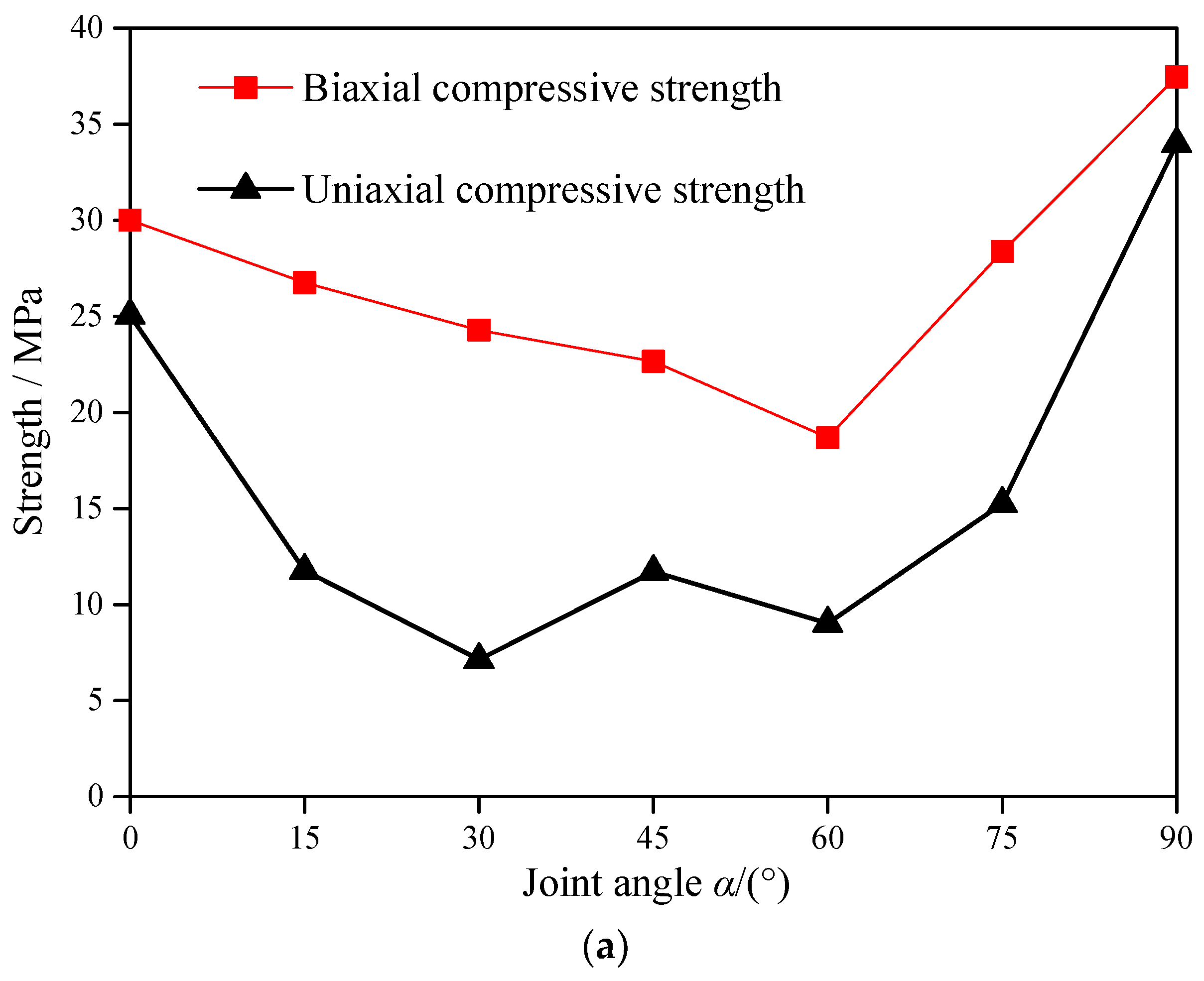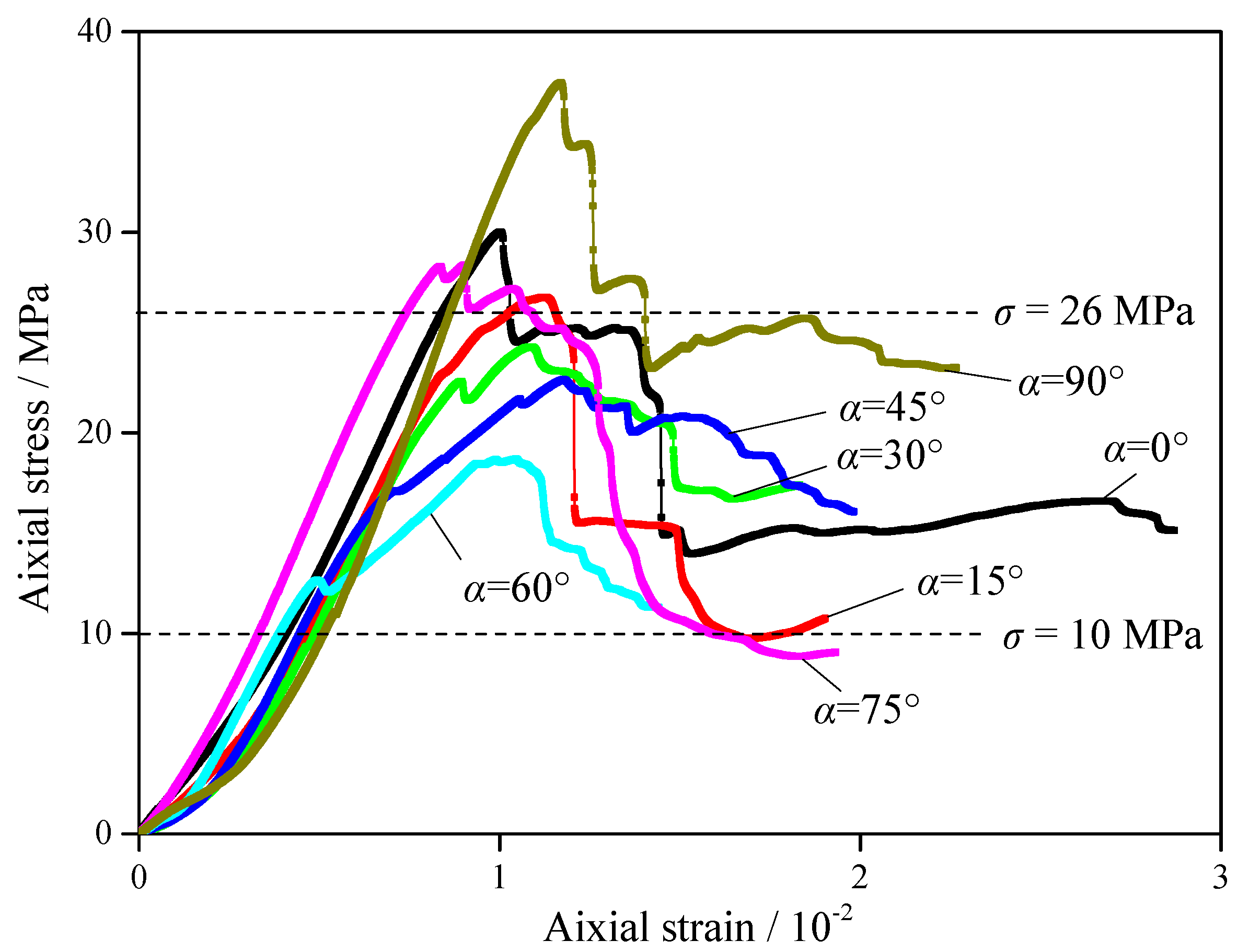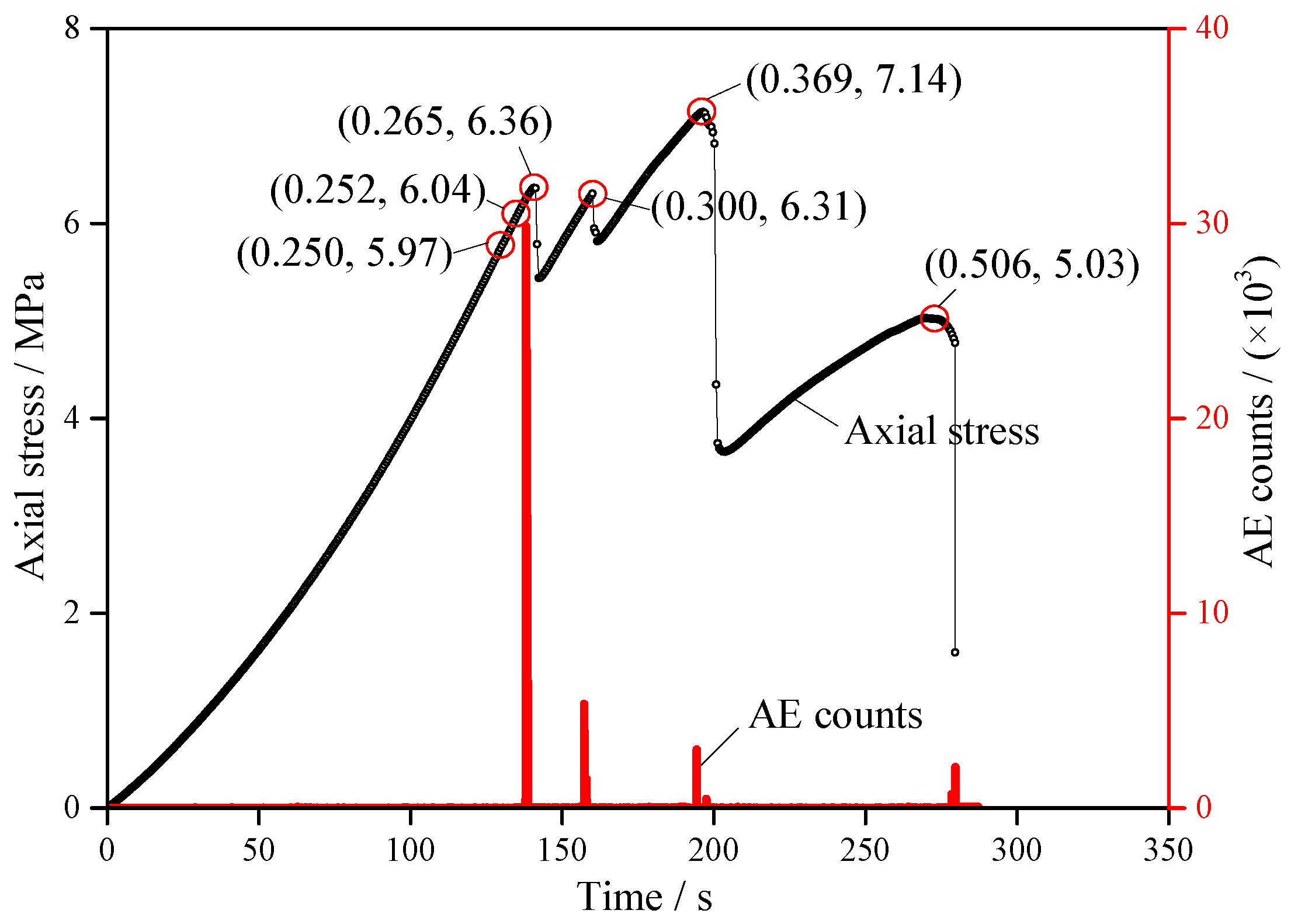The Effect of Joint Dip Angle on the Mechanical Behavior of Infilled Jointed Rock Masses under Uniaxial and Biaxial Compressions
Abstract
:1. Introduction
2. Experiments
2.1. Specimen Morphology
2.2. Specimen Preparation
2.3. Experimental Unit
3. Results and Analysis
3.1. Mechanical Properties of Intact Specimen under Uniaxial Compression
3.2. Effect of α under Uniaxial Compression
- (1)
- Figure 4 shows the axial stress–strain curves of specimens with different α under uniaxial compression. When α = 0°–90°, the axial stress–strain curve appears to undergo multiple drops in the pre-peak and post-peak stage, which indicates that the specimens maintain a clearly brittle characteristic. In addition, the residual strengths of the specimens under uniaxial compression are less than 9 MPa.
- (2)
- Figure 5a depicts the relationship between uniaxial/biaxial compressive strength and α. The uniaxial compressive strength shows a W-shaped change with an increase in α, which is consistent with that reported by Chen et al. (2013). As α increases from 0° to 30°, the uniaxial compressive strength decreases from 25.04 MPa to 7.14 MPa, which is a reduction of 71.5%. As α increases from 30° to 60°, the uniaxial compressive strength fluctuates within a small range. When α continuously increases from 60° to 90°, the uniaxial compressive strength increases from 9.01 MPa to 33.99 MPa, which is an increase of 277%. When α = 90°, the uniaxial compressive strength is 35.7% higher than that of α = 0°. Therefore, when the direction of the fractures is perpendicular to the loading direction (α = 90°), the bearing capacity of the specimen is at its largest, followed by that parallel to the loading direction (α = 0°). However, the uniaxial compressive strength of the specimens has a minimum value when α = 30°, which is slightly lower than that for α = 60°.
- (3)
- Figure 5b presents the relationship between the elasticity modulus and α. For uniaxial compression tests, the elasticity modulus shows a W-shaped variation with an increase in α, which is similar to that in Figure 5a. As α increases from 0° to 30°, the elasticity modulus decreases from 3.76 GPa to 3.26 GPa, which is a reduction of 13.3%. As α increases from 30° to 60°, the elasticity modulus fluctuates within a small range. When α continuously increases from 60° to 90°, the elasticity modulus increases from 3.47 GPa to 4.83 GPa, which is an increase of 39.2%. When α = 30°, the elasticity modulus of the specimen reaches its minimum value, which is 67.3% of the average value of the maximum elastic modulus of the intact specimen. When α = 90°, the elasticity modulus of the specimen reaches its maximum value, which is 99.7% of the average value of the maximum elastic modulus of the intact specimen.
3.3. Effect of α under Biaxial Compression
- (1)
- Figure 6 displays the axial stress–strain curves of specimens with different α under biaxial compression. In contrast to uniaxial compression, all the axial stress–strain curves show multiple peaks under biaxial compression. The residual strengths of the specimens under biaxial compression are between 10–26 MPa, which are obviously greater than that of uniaxial compression. The plastic deformation ability of the post-peak stage under biaxial compression is improved when the joint orientation and the loading direction have a certain angle (α = 0°–90°).
- (2)
- Figure 5a depicts the relationship between the strength and the α of specimens. For biaxial compressions, the biaxial compressive strength shows a V-shaped change with an increase in α. When α = 60°, the biaxial compressive strength of the specimen reaches a minimum value of 18.69 MPa, while the biaxial compressive strength of the specimen reaches a maximum value of 37.46 MPa when α = 90°. When α is fixed, the biaxial compressive strength of the specimen is much greater than that of uniaxial compressive strength, as shown in Table 2. When α is 0° and 90°, the biaxial compressive strength of the specimen is increased by 19.82% and 10.21% compared with uniaxial compressive strength, respectively. For α = 15°–75°, the biaxial compressive strength of the specimen increases by more than 85.96% compared with uniaxial compressive strength; for example, when α = 15°, the biaxial compressive strength is increased by 127.19% compared with uniaxial compressive strength.
- (3)
- Figure 5b exhibits the relationship between the elasticity modulus and α of the specimen. For biaxial compressions, the elasticity modulus under biaxial compression shows a V-shaped change with an increase in α. As α increases from 0° to 60°, the elasticity modulus under biaxial compression decreases from 3.93 GPa to 3.51 GPa, which is a reduction of 10.69%. When α increases from 60° to 90°, the elasticity modulus under biaxial compression increases from 3.51 GPa to 5.02 GPa, which is an increase of 43.02%. Since α is a constant, the elasticity modulus of the specimen under biaxial compression has an increase of approximately 12.58% with respect to that of uniaxial compression, as shown in Table 2.
3.4. Analysis of Crack Propagation and AE Response Characteristics
3.5. Error Analysis and Supplemented the Highlights and Limitations of This Study
4. Evolution of Failure Mode
4.1. Effect of α
4.2. Effect of Biaxial Compression
5. Conclusions
- (1)
- The uniaxial compressive strength shows a W-shaped change with an increase in the dip angle, and the uniaxial compressive strength of the specimens reached its minimal values at α = 30° and α = 60°.
- (2)
- The biaxial compressive strength shows a V-shaped change with an increase in the dip angle. When α = 60°, the biaxial compressive strength of the specimen reached a minimum value of 18.69 MPa, while when α = 90°, the biaxial compressive strength of the specimen reached a maximum value of 37.46 MPa. When the direction of the fractures was perpendicular to the loading direction (α = 90°), the bearing capacity of the specimen was the largest, followed by that parallel to the loading direction (α = 0°).
- (3)
- Under uniaxial compression, the specimens exhibited three failure modes: splitting failure of type 1 (the specimen split along the width direction), step-path failure, and planar failure. Under biaxial compression, the specimens exhibited two failure modes: splitting failure of type 2 (the specimen split along the thickness direction) and planar failure.
Author Contributions
Acknowledgments
Conflicts of Interest
References
- Jing, H.; Yang, S.; Zhang, M.; Xu, G.; Chen, K. An experimental study on anchorage strength and deformation behavior of large-scale jointed rock mass. Tunn. Undergr. Space Technol. 2014, 43, 184–197. [Google Scholar] [CrossRef]
- Huang, Z.; Broch, E.; Lu, M. Cavern roof stability-mechanism of arching and stabilization by rockbolting. Tunn. Undergr. Space Technol. 2002, 17, 249–261. [Google Scholar] [CrossRef]
- Zhang, Q.; Zhang, C.; Jiang, B.; Li, N.; Wang, Y. Elastoplastic coupling solution of circular openings in strain-softening rock mass considering pressure-dependent effect. Int. J. Geomech. 2018, 18, 04017132. [Google Scholar] [CrossRef]
- Liu, R.; Li, B.; Jiang, Y.; Yu, L. A numerical approach for assessing effects of shear on equivalent permeability and nonlinear flow characteristics of 2-D fracture networks. Adv. Water Resour. 2018, 111, 289–300. [Google Scholar] [CrossRef]
- Yang, X.; Kulatilake, P.; Chen, X.; Jing, H.; Yang, S. Particle flow modeling of rock blocks with nonpersistent open joints under uniaxial compression. Int. J. Geomech. 2016, 16, 04016020. [Google Scholar] [CrossRef]
- Brace, W.; Byerlee, J. Recent experimental studies of brittle fracture of rocks. In Proceedings of the 8th US Symposium on Rock Mechanics, Minneapolis, MN, USA, 15–17 September 1966; American Rock Mechanics Association: Alexandria, VA, USA, 1966. [Google Scholar]
- Hoek, E.; Bieniawski, Z. Brittle fraeture propagation in rock under compression. Int. J. Fract. 1984, 26, 276–294. [Google Scholar] [CrossRef]
- Yang, S.; Jing, H. Strength failure and crack coalescence behavior of brittle sandstone samples containing a single fissure under uniaxial compression. Int. J. Fract. 2011, 168, 227–250. [Google Scholar] [CrossRef]
- Zhang, X.; Wong, L. Cracking processes in rock-like material containing a single flaw under uniaxial compression: A numerical study based on parallel bonded-particle model approach. Rock Mech. Rock Eng. 2012, 45, 711–737. [Google Scholar] [CrossRef]
- Wong, L.; Einstein, H. Crack coalescence in molded gypsum and Carrara marble: Part 1. Macroscopic observations and interpretation. Rock Mech. Rock Eng. 2009, 42, 475–511. [Google Scholar] [CrossRef]
- Yang, S.; Huang, Y.; Jing, H.; Liu, X. Discrete element modeling on fracture coalescence behavior of red sandstone containing two unparallel fissures under uniaxial compression. Eng. Geol. 2014, 178, 28–48. [Google Scholar] [CrossRef]
- Tang, C.; Lin, P.; Wong, R.; Chau, K. Analysis of crack coalescence in rock-like materials containing three flaws—Part II: Numerical approach. Int. J. Rock Mech. Min. Sci. 2001, 38, 925–939. [Google Scholar] [CrossRef]
- Yang, S.; Yang, D.; Jing, H.; Li, Y.; Wang, S. An experimental study of the fracture coalescence behaviour of brittle sandstone specimens containing three fissures. Rock Mech. Rock Eng. 2012, 45, 563–582. [Google Scholar] [CrossRef]
- Bobet, A.; Einstein, H. Fracture coalescence in rock-type materials under uniaxial and biaxial compression. Int. J. Rock Mech. Min. Sci. 1998, 35, 863–888. [Google Scholar] [CrossRef]
- Tiwari, R.; Rao, K. Post failure behavior of a rock mass under the influence of triaxial and true triaxial confinement. Eng. Geol. 2006, 84, 112–129. [Google Scholar] [CrossRef]
- Gehle, C.; Kutter, H. Breakage and shear behaviour of intermittent rock joints. Int. J. Rock Mech. Min. Sci. 2003, 40, 687–700. [Google Scholar] [CrossRef]
- Zhang, B.; Li, S.; Zhang, D.; Li, M.; Shao, D. Uniaxial compression mechanical property test, fracture and damage analysis of similar material of jointed rock mass with filled cracks. Rock Soil Mech. 2012, 33, 1647–1652. [Google Scholar]
- Prudencio, M.; Van Sint Jan, M. Strength and failure modes of rock mass models with non-persistent joints. Int. J. Rock Mech. Min. Sci. 2007, 44, 890–902. [Google Scholar] [CrossRef]
- Goldstein, M.; Goosev, B.; Pvrogovsky, N.; Tulinov, R.; Turovskaya, A. Investigation of mechanical properties of cracked rock. In Proceedings of the 1st International Congress on Rock Mechanics, Lisbon, Portugal, 25 September–1 October 1966; pp. 521–524. [Google Scholar]
- Chen, X.; Liao, Z.; Peng, X. Cracking process of rock mass models under uniaxial compression. J. Cent. South Univ. 2013, 20, 1661–1678. [Google Scholar] [CrossRef]
- Bahaaddini, M.; Sharrock, G.; Hebblewhite, B. Numerical investigation of the effect of joint geometrical parameters on the mechanical properties of a non-persistent jointed rock mass under uniaxial compression. Comput. Geotech. 2013, 49, 206–225. [Google Scholar] [CrossRef]
- Yang, X.; Kulatilake, P.; Jing, H.; Yang, S. Numerical simulation of a jointed rock block mechanical behavior adjacent to an underground excavation and comparison with physical model test results. Tunn. Undergr. Space Technol. 2015, 50, 129–142. [Google Scholar] [CrossRef]
- Asadizadeh, M.; Moosavi, M.; Hossaini, M.; Masoumi, H. Shear Strength and Cracking Process of Non-persistent Jointed Rocks: An Extensive Experimental Investigation. Rock Mech. Rock Eng. 2018, 51, 415–428. [Google Scholar] [CrossRef]
- Wu, L.; Li, B.; Huang, R.; Sun, P. Experimental study and modeling of shear rheology in sandstone with non-persistent joints. Eng. Geol. 2017, 222, 201–211. [Google Scholar] [CrossRef]
- Sarfarazi, V.; Haeri, H.; Shemirani, A.; Zhu, Z. Shear Behavior of Non-Persistent Joint under High Normal Load. Strength Mater. 2017, 49, 320–334. [Google Scholar] [CrossRef]
- Lajtai, E.; Carter, B.; Duncan, E. En echelon crack-arrays in potash salt rock. Rock Mech. Rock Eng. 1994, 27, 89–111. [Google Scholar] [CrossRef]
- Su, H.; Jing, H.; Du, M.; Wang, C. Experimental investigation on tensile strength and its loading rate effect of sandstone after high temperature treatment. Arabian J. Geosci. 2016, 9, 1–11. [Google Scholar] [CrossRef]











| Number | α (°) | Lj (mm) | Lr (mm) | d (mm) | σc (MPa) | E (GPa) | Remarks |
|---|---|---|---|---|---|---|---|
| I01 | - | - | - | - | 34.05 | 4.86 | Intact specimens |
| I02 | - | - | - | - | 33.60 | 4.83 | |
| U01 | 0 | 16 | 12 | 30 | 25.04 | 3.76 | Uniaxial compression test |
| U02 | 15 | 16 | 12 | 30 | 11.78 | 3.47 | |
| U03 | 30 | 16 | 12 | 30 | 7.14 | 3.26 | |
| U04 | 45 | 16 | 12 | 30 | 11.71 | 3.62 | |
| U05 | 60 | 16 | 12 | 30 | 9.01 | 3.47 | |
| U06 | 75 | 16 | 12 | 30 | 15.26 | 4.10 | |
| U07 | 90 | 16 | 12 | 30 | 33.99 | 4.83 | |
| B01 | 0 | 16 | 12 | 30 | 30.01 | 3.93 | Biaxial compression test |
| B02 | 15 | 16 | 12 | 30 | 26.75 | 3.74 | |
| B03 | 30 | 16 | 12 | 30 | 24.28 | 3.67 | |
| B04 | 45 | 16 | 12 | 30 | 22.65 | 3.61 | |
| B05 | 60 | 16 | 12 | 30 | 18.69 | 3.51 | |
| B06 | 75 | 16 | 12 | 30 | 28.37 | 4.17 | |
| B07 | 90 | 16 | 12 | 30 | 37.46 | 5.02 |
| Dip Angle | σc (Uniaxial, MPa) | σc (Biaxial, MPa) | Improved (%) | E (Uniaxial, GPa) | E (Biaxial, GPa) | Improved (%) |
|---|---|---|---|---|---|---|
| 0 | 25.04 | 30.01 | 19.82 | 3.76 | 3.93 | 4.52 |
| 15 | 11.78 | 26.75 | 127.19 | 3.47 | 3.74 | 7.78 |
| 30 | 7.14 | 24.28 | 239.86 | 3.26 | 3.67 | 12.58 |
| 45 | 11.71 | 22.65 | 93.42 | 3.62 | 3.61 | −0.28 |
| 60 | 9.01 | 18.69 | 107.19 | 3.47 | 3.51 | 1.15 |
| 75 | 15.26 | 28.37 | 85.96 | 4.10 | 4.17 | 1.71 |
| 90 | 33.99 | 37.46 | 10.21 | 4.83 | 5.02 | 3.93 |
© 2018 by the authors. Licensee MDPI, Basel, Switzerland. This article is an open access article distributed under the terms and conditions of the Creative Commons Attribution (CC BY) license (http://creativecommons.org/licenses/by/4.0/).
Share and Cite
Han, G.; Jing, H.; Jiang, Y.; Liu, R.; Su, H.; Wu, J. The Effect of Joint Dip Angle on the Mechanical Behavior of Infilled Jointed Rock Masses under Uniaxial and Biaxial Compressions. Processes 2018, 6, 49. https://doi.org/10.3390/pr6050049
Han G, Jing H, Jiang Y, Liu R, Su H, Wu J. The Effect of Joint Dip Angle on the Mechanical Behavior of Infilled Jointed Rock Masses under Uniaxial and Biaxial Compressions. Processes. 2018; 6(5):49. https://doi.org/10.3390/pr6050049
Chicago/Turabian StyleHan, Guansheng, Hongwen Jing, Yujing Jiang, Richeng Liu, Haijian Su, and Jiangyu Wu. 2018. "The Effect of Joint Dip Angle on the Mechanical Behavior of Infilled Jointed Rock Masses under Uniaxial and Biaxial Compressions" Processes 6, no. 5: 49. https://doi.org/10.3390/pr6050049








